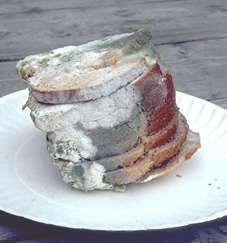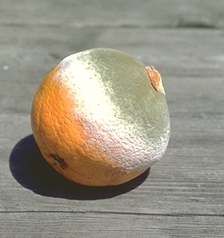Main page >> Moulds and their characteristics >> How moulds are classified >> Where moulds are found >> How moulds can be isolated >> How moulds are grown >> Contamination >> Moulds under the microscope >> How moulds are identified >> Index of descriptions >> Bibliography
MOULDS AND THEIR CHARACTERISTICS


Moulds, those dusty little spots often found spreading over bread, cheese, books, and other things in the home, cause the loss of millions of dollars to our economy every year and, even worse, may be a menace to your health. To deal with them successfully we must understand what moulds are and exactly what they are doing.
Moulds are microscopic, plant-like organisms, composed of long filaments called hyphae. Mould hyphae grow over the surface and inside nearly all substances of plant or animal origin. Because of their filamentous construction and consistent lack of chlorophyll they are considered by most biologists to be separate from the plant kingdom and members of the kingdom of fungi. They are related to the familiar mushrooms and toadstools,differing only in not having their filaments united into large fruiting structures. For our purposes here, we shall consider as moulds only fungi that are commonly encountered n the home and laboratory and that can be easily grown and studied.
When mould hyphae are numerous enough to be seen by the naked eye they form a cottony mass called a mycelium. It is the hyphae and resulting mycelia that invade things in our homes and cause them to decay.
Reproduction in fungi is complex and involves a great diversity of structures. At the most fundamental level we can say that most moulds reproduce by spores. Spores are like seeds; they germinate to produce a new mould colony when they land in a suitable place. Unlike seeds, they are very simple in structure and never contain an embryo or any sort of preformed offspring. Spores are produced in a variety of ways and occur in a bewildering array of shapes and sizes. In spite of this diversity, spores are quite constant in shape, size, colour and form for any given mould, and are thus very useful for mould identification.
The most basic difference between spores lies in their method of initiation, which can be either sexual or asexual. Sexually initiated spores result from a mating between two different organisms or hyphae, whereas asexual spores result from a simple internal division or external modification of an individual hypha. the recognition of a mating and subsequent spore formation is often difficult for an observer,and is usually reserved for patient specialists. However, for practical purposes one can learn to recognize certain indications of the sexual process, namely, the four kinds of sexually determined spores that appear in mould fungi: (1) oospores, (2) zygospores, (3) ascospores, and (4) basidiospores.
Oospores (Figure 1) are produced when male gametes (reproductive nuclei)enter a large spherical cell (oogonium) and fertilize the eggs within. The result, as seen in routine examination, is numerous oogonia containing one to several spherical and often brownish eggs. The oogonia are usually penetrated by one or more hyphae (antheridia) that give rise to the male nuclei.
Zygospores (Figure 2 and zygospore illustration) do not occur inside any kind of enclosing structure, but are produced by the direct fusion of two hyphal protrusions (suspensors) from neighbouring filaments. Usually zygospores are recognized as large,nearly spherical, often dark brown or black, rough-walled spores with two connecting hyphae, representing the two mating gametangia (figure 2C). Sometimes the zygospore may be surrounded by several finger-like extensions from the two gametangia.
Ascospores (Figure 3) are produced within spherical to cylindrical cells called asci, most often in groups of four or eight (figure 3A). Usually the asci are produced within some kind of enclosing structure and thus are not found exposed on the hyphae. In a few cases the asci may be borne among hyphae and resemble oogonia with eggs, but they will never be penetrated by any sort of fertilizing hypha. Fertilization occurs early in the life cycle and is not evident at the time ascospores are produced.
Basidiospores (Figure 4) are always produced externally on a structure called a basidium. Basidia come in a variety of forms, but those commonly encountered on moulds will be club-shaped and bear four or eight spores on sharp projections at the apex. At first it may be difficult to distinguish between a basidiospores and one of the asexually initiated spore types, but one should always suspect the presence of basidia when externally produced spores consistently occur in groups fo four or eight (figure 4). As with ascospores, basidiospores are the result of an early fertilization that is not easily observed.
Asexual spores usually occur either in sporangia or as conidia. Sporangia are modified hyphae or cells containing numerous spores (sporangiospores). They never have more than a single connecting hypha and the spores do not constantly occur in groups of four or eight as do ascospores.
Conidia are the most difficult group to characterize because of their great diversity of form. The only feature that most conidia have in common is that they occur externally on the cells that produce them. These conidium-bearing (conidiogenous) cells may occur within rather specialized or characteristic structures that resemble those that frequently bear asci, however, and it is often necessary to break them open to confirm that the spores are truly conidia and not ascospores. Conidia that are borne on the hyphae, without any kind of compound fruiting structure, are the most commonly encountered type. Structures that completely enclose the conidium-bearing cells are called pycnidia, and those resulting from a fusion of conidium-bearing cells are called synnemata if they are longer than they are broad or sporodochia if broader than long.